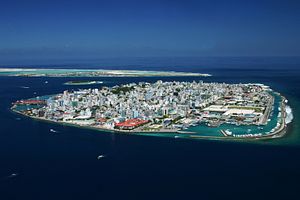The election results in the Maldives in September 2018 were tailor-made for a simple geopolitical narrative: Ibrahim ‘Ibu’ Mohamed Solih’s surprise victory as the joint opposition candidate was India’s gain and China’s loss.
Under the former autocratic-leaning president, Abdulla Yameen, the Maldives not only found itself diverging from New Delhi as it cast aside democracy and the rule of law, but it took on millions in Chinese debt.
In the months since the election—and in particular since the November inauguration of the new government led by Solih—the country has been working to take stock of just exactly what was done under Yameen’s tenure.
The effort culminated last week in Maldivian authorities announcing charges against the former president. Yameen was charged with with grand corruption, money-laundering, and theft by Maldivian police on Wednesday evening.
Solih, during his inaugural address, which was attended by Indian Prime Minister Narendra Modi, underscored his concern about the country’s sovereign debts.
He sharply criticized the previous’ government’s decision to pursue “reckless mega development projects undertaken purely for political gains,” which he cited as the cause of the Maldives’s “dire economic situation.”
“Large-scale embezzlement and corruption have dwindled the coffers of the state by billions of rufiyaa. This money belongs to the Maldivian people, money that should have been spent for the common good of the people,” Solih added at the time.
To date, however, there hasn’t been a good public estimate of just how far the Maldives, a small archipelagic nation with real GDP just shy of $5 billion, found itself in debt to China by the end of Yameen’s tenure.
A new report by the Financial Times offers some answers. Citing data provided by the Maldivian foreign ministry, the report outlines more than $1 billion in outstanding commitments:
Over the past two months, the Maldives has been struggling to establish the full scale of its exposure to Chinese debt, most of which is in the form of sovereign guarantees on Chinese loans to companies. Finance ministry data show that these guarantees amount to $935m, on top of the $600m directly owed to Beijing by the government.
A separate and as-yet-unsubstantiated estimate by Mohamed Nasheed, the country’s former president, puts the figure at as high as $3 billion.
With the effort to tally now mostly concluded, the Maldivian government under Solih will have to seek more favorable terms on existing loans and guarantees directly from China. That means that—at least in the short-term—Solih won’t have a free hand to directly pull the rug out from underneath ongoing China-backed projects in the country.
Chinese President Xi Jinping had visited the Maldives in September 2014, as part of a three-nation tour of South Asia. At the time, he announced that the country would become a part of the Maritime Silk Road, a component of what was then the “One Belt, One Road” Initiative and his since been rebranded the Belt and Road Initiative.

































